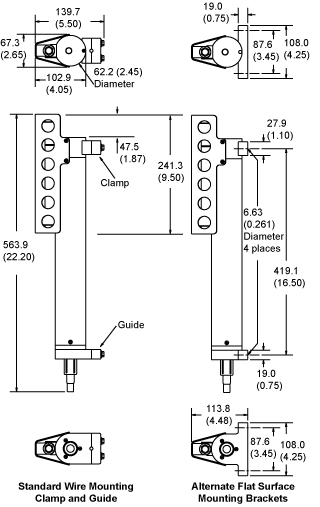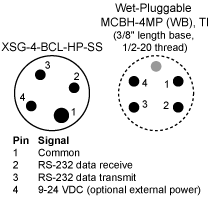![]()
![]() Print version
Current manual - RS-232 or
RS-485 (for older manuals,
click here)
Reference Sheet -
RS-232 or
RS-485
Configuration options & accessories
Print version
Current manual - RS-232 or
RS-485 (for older manuals,
click here)
Reference Sheet -
RS-232 or
RS-485
Configuration options & accessories
DESCRIPTION
|
|
The SBE 37-SM MicroCAT is a high-accuracy conductivity and temperature (pressure optional) recorder with Serial interface, internal battery, and non-volatile FLASH Memory. The MicroCAT is designed for moorings or other long duration, fixed-site deployments. Constructed of titanium and other non-corroding materials to ensure long life with minimum maintenance, the MicroCAT's depth capability is 7000 meters (23,000 feet); it is also available with an optional 250-meter (820-feet) plastic ShallowCAT housing.
Calibration coefficients are stored in EEPROM, allowing the MicroCAT to output data in ASCII engineering units (decimal or XML format); raw output is also available. The data always includes Conductivity, Temperature, Pressure (if optional pressure sensor is installed), and time. If desired, the MicroCAT can calculate and output salinity and sound velocity (Chen-Millero).
The MicroCAT retains the temperature and conductivity sensors used in our time-proven SEACAT and SEACAT plus products. Electrical isolation of the conductivity electronics eliminates any possibility of ground-loop noise. The MicroCAT’s unique internal-field conductivity cell permits the use of expendable anti-foulant devices. The aged and pressure-protected thermistor has a long history of exceptional accuracy and stability.
The optional Druck pressure sensor has a superior design that is entirely different from conventional ‘silicon’ types in which the deflection of a metallic diaphragm is detected by epoxy-bonded silicon strain gauges. The Druck sensor employs a micro-machined silicon diaphragm into which the strain elements are implanted using semiconductor fabrication techniques. Unlike metal diaphragms, silicon’s crystal structure is perfectly elastic, so the sensor is essentially free of pressure hysteresis. Compensation of the temperature influence on pressure offset and scale is performed by the MicroCAT’s CPU.
SENSOR INTERFACE ELECTRONICS
Temperature is acquired by applying an AC excitation to a hermetically sealed VISHAY reference resistor and an ultra-stable aged thermistor (drift rate typically less than 0.002 °C per year). The ratio of thermistor resistance to reference resistance is determined by a 24-bit A/D converter; this A/D also processes the pressure sensor signal. Conductivity is acquired using an ultra-precision Wien-Bridge oscillator.
COMMUNICATIONS AND INTERFACING
The MicroCAT communicates directly with a computer via standard RS-232 interface. Data can be uploaded at up to 115.2K baud. Real-time data can be transmitted at distances of up to 1600 meters (5200 feet) at 600 baud, simultaneous with recording. Firmware upgrades can be downloaded through the communications port by the user, without opening the instrument. An optional RS-485 interface allows multiple MicroCATs to share a common 2-wire cable, minimizing cable complexity for C-T chains.
User-selectable operating modes include:
SOFTWARE
The MicroCAT is supplied with a powerful Windows 2000/XP software package, SEASOFT© V2, which includes:
DATA STORAGE, FORMAT, AND BATTERY ENDURANCE
Temperature and conductivity are stored 6 bytes/sample, time 4 bytes/sample, and optional pressure 5 bytes/sample; memory capacity is in excess of 530,000 samples. The MicroCAT is powered by a 10.6 Amp-hour (nominal) battery pack consisting of twelve AA lithium batteries (Saft LS14500) which, when removed from the MicroCAT, can be shipped via commercial aircraft. The pack provides sufficient internal battery capacity for more than 630,000 samples for a typical sampling scheme. *
SPECIFICATIONS
|
Measurement Range |
Initial Accuracy |
Typical Stability |
Resolution | |
| Conductivity |
0
to 7 S/m (0 to 70 mS/cm) |
0.0003 S/m (0.003 mS/cm) |
0.0003 S/m (0.003 mS/cm) per month |
0.00001 S/m (0.0001 mS/cm) |
|
Temperature (°C) |
-5 to 35 | 0.002 | 0.0002 per month | 0.0001 |
| Optional Pressure |
20 / 100 / 350 /
600 /
1000 / 2000 / 3500 / 7000 m (Expressed in meters of deployment depth capability) |
0.1% of full scale range | 0.05% of full scale range per year | 0.002% of full scale range |
Clock Accuracy: 5 seconds/month
Quiescent Current: 30 microamps *
Sampling and Communication Current: *
Communication 4.3 milliamps
Sampling
15 milliamps if transmitting real-time data;
13 milliamps if not transmitting real-time data
* Power consumption / battery endurance values are for standard RS-232 interface; for optional RS-485 interface, see RS-485 manual.
Acquisition Time: 1.8 - 2.6 seconds per sample, dependent on sampling mode and inclusion of pressure sensor
Power Supply: 10.6 Amp-hour (nominal) battery pack
Optional External Power: 0.5 Amps at 9 - 24 VDC
Housing, Depth Rating, and Weight (without pressure sensor):
| Housing Material | Depth Rating | Weight | |
| Standard | Titanium | 7000 m (23,000 feet) |
3.8 kg (8.3 lbs) in
air 2.3 kg (5.1 lbs) |
| Optional ShallowCAT | Plastic | 250 m (820 ft) |
2.7 kg (6.0 lbs) in
air 1.2 kg (2.7 lbs) in water |
Dimensions: in millimeters (inches)

Connector:

ADDITIONAL INFORMATION / LINKS:
Documentation -- manual, photos, technical papers, application notes, etc.
Sales Information -- options, accessories, cables, mount kits, spares, etc.
Software -- components of Seasoft V2
Links to Other Instruments of Interest
![]()
Specifications are subject to change without notice.
Last modified: 04-Mar-2011
Sea-Bird Home Phone: (+1) 425-643-9866 Fax: (+1) 425-643-9954 E-mail: seabird@seabird.com